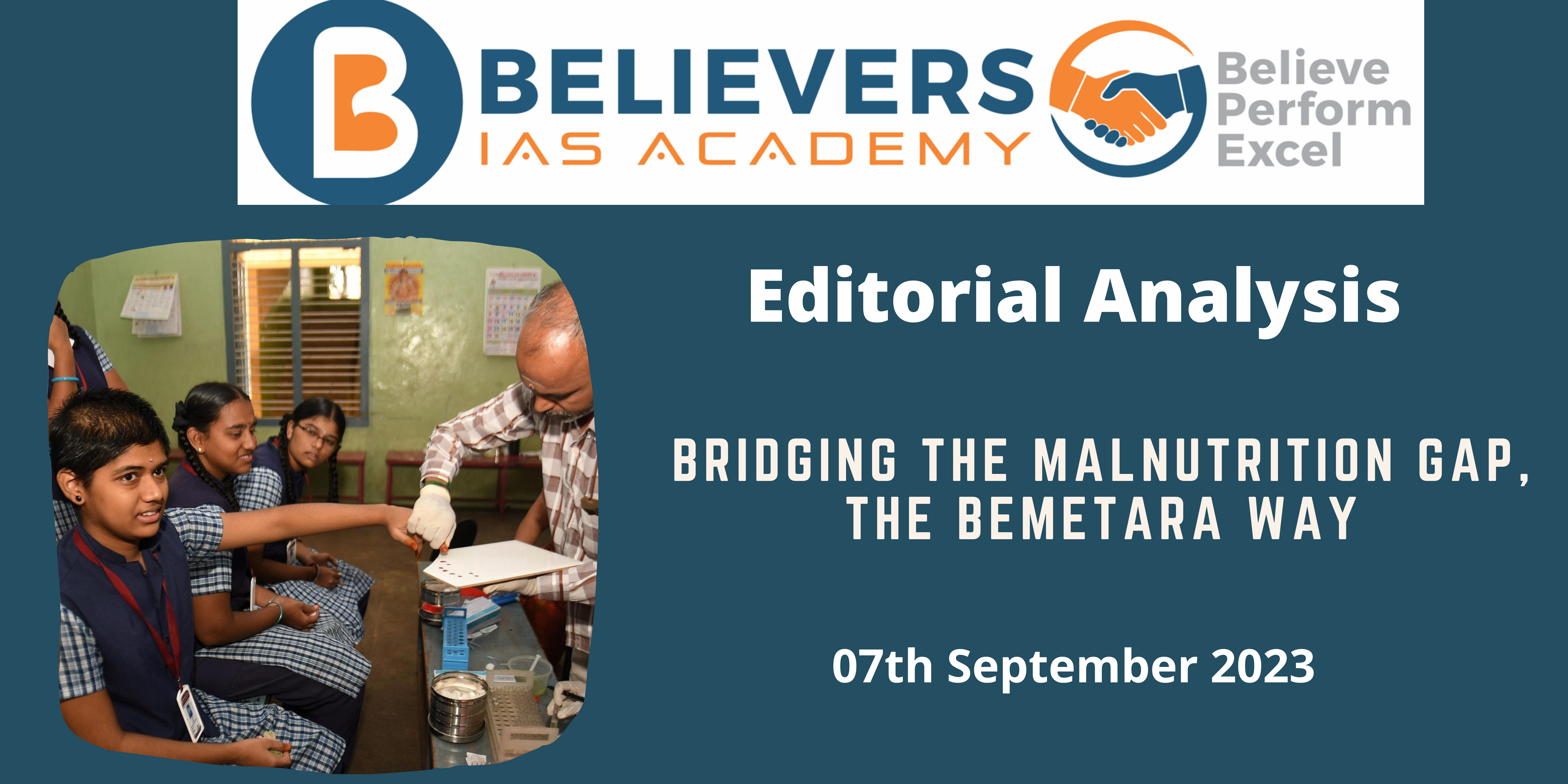Bridging the Malnutrition Gap, the Bemetara Way
Context:
The battle against malnutrition persists due to many factors – inadequate knowledge of proper eating practices, prevalence of myths about food, etc. Hence, to ensure food security and addressing malnutrition, an effective approach called Nutrition Counselling is in news.
Relevance:
GS-02 (Issues Related to Children and Women, Health, Government Policies & Interventions)
Prelims:
- Malnutrition
- Global Hunger Index
- POSHAN Abhiyaan
- Severe Acute Malnutrition (SAM)
Mains Question:
- Discuss the role of nutrition counselling in combating malnutrition in India, with a focus on its effectiveness, challenges, and potential for widespread implementation. (150 words)
Dimensions of the Article:
- Challenge of Malnutrition
- The Case of Bemetara, Chhattisgarh
- Potth Laika Abhiyaan: Nutrition Counselling and Monitoring
- Encouraging Outcomes
- Cost-Effective Approach
Challenge of Malnutrition
- Despite efforts to enhance food security, malnutrition remains a pressing issue in India. Programs like the Prime Minister’s Overarching Scheme for Holistic Nourishment (POSHAN) Abhiyaan have incorporated social and behavior change communication (SBCC), which includes various awareness initiatives.
- However, the systematic implementation of nutrition counselling is yet to be established uniformly across states.
The Case of Bemetara, Chhattisgarh
- Bemetara, a relatively prosperous district in Chhattisgarh, puzzles observers due to its high prevalence of Severe Acute Malnutrition (SAM) among children. This problem highlights the significance of nutrition education.
- Potth Laika Abhiyaan, meaning “Healthy Child Mission” in the Chhattisgarhi language, is a nutrition counselling program operating in 72 severely affected Anganwadi Centres (AWCs) in Bemetara.
- Supported by UNICEF, Chhattisgarh, this initiative trains ground-level staff from the Health and Women and Child Development departments to provide nutrition counselling to parents of SAM and Medium Acute Malnutritioned (MAM) children.
Potth Laika Abhiyaan: Nutrition Counselling and Monitoring
- Every Friday, parents are counseled in simple language about the importance of a balanced diet, hand hygiene, and other health-related tips.
- This counseling dispels harmful dietary myths and superstitions. Moreover, the progress of targeted children is closely monitored. Local leaders, including sarpanchs, panchayat sachivs, and religious figures, participate in these sessions.
- Door-to-door visits are conducted to monitor the children’s progress.
Encouraging Outcomes
- The results of Potth Laika Abhiyaan are promising. Over nine months, from December 2022 to July 2023, 53.77% of targeted children have shown improvement and were brought out of malnutrition.
- Specifically, 61.5% of MAM children and 14.67% of SAM children experienced positive changes. Comparing these outcomes with a control group of 20 AWCs where the mission was not implemented, the effectiveness of the program becomes evident.
- The control group showed only a 30.6% improvement, with no SAM children benefiting. This highlights a substantial 23% increase in the rate of improvement compared to the control group.
Cost-Effective Approach
- Notably, Potth Laika Abhiyaan is a cost-effective initiative. Unlike providing meals, which requires significant budgeting and risks of leakage, this program involves minimal expenses, primarily training and regular monitoring. Thus, it has demonstrated its cost-effectiveness in tackling malnutrition.
Way Forward:
- To truly accelerate the eradication of malnutrition, the success of Potth Laika Abhiyaan needs replication on a broader scale across districts and states.
- It is essential to complement food distribution to the disadvantaged with nutrition counselling and monitoring. Only through the widespread implementation of this straightforward yet impactful strategy can India move closer to realizing the ambitious and noble goal of a “Kuposhan Mukt Bharat” or a “Malnutrition-Free India.”
Conclusion:
Nutrition counselling stands as a powerful tool in addressing malnutrition in India. While the nation has made commendable efforts to ensure food security, the persistence of malnutrition issues underscores the importance of educating people on proper eating practices. The success story of Potth Laika Abhiyaan in Bemetara, Chhattisgarh, demonstrates that this simple and cost-effective approach, when implemented systematically and widely, can significantly contribute to achieving a malnutrition-free India. It is a reminder that sometimes, simplicity is the most sophisticated solution to complex challenges.



